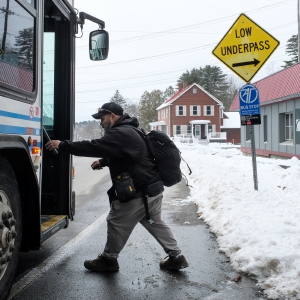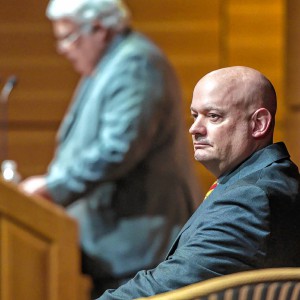Out & About: Valley Street Dam evokes another era of summer fun, virus shutdowns
| Published: 06-06-2020 10:19 PM |
From 1938 to the early 1950s, the Valley Street Dam was the place in be in Springfield, Vt., in the summer.
Constructed specifically to create a swimming hole, the dam was where families went to be together and where teenagers would hang out, where a generation of children learned to dog paddle and freestyle. And that was its role until 1953, when, in a move that sounds all too familiar in the age of COVID-19, the dam was closed amid worries about a different virus — polio.
“It was a cooperative effort between the town, the recreation committee, the chamber of commerce and interested citizens,” said Bunni Putnam, president of the Springfield Art and Historical Society. “They had to dig the basin out with a steam shovel and they built the dam and the parking area.”
Now in great disrepair, the Valley Street Dam is slated to be removed in the next few years once funding comes through, an end to a relic from a time that had far less concern about the environmental impact of municipal projects.
“There’s a lot of negative aspects, adverse impacts of dams and if they’re no longer serving a useful purpose there’s a lot of good reasons to take them out,” said river management engineer in the Watershed Management Division, Rivers Program in the Vermont Department of Environmental Conservation. “They block fish passage, the salamanders and the frogs. Taking them down is a flood resilience effort.”
The Valley Street Dam was one of a few (including the Norwich Pool, which was wiped out by Tropical Storm Irene in 2011) that were built in Vermont in the 1920s, ’30s and ’40s to be used as a public swimming pool, said Paula Sagerman, an independent historic preservation consultant based in Brattleboro, Vt., who researched the Valley Street Dam for a Division for Historic Preservation report.
“I did not know that, before this, dams were built for that purpose,” Sagerman said. “Very few of them survived, so it’s not something the general public was aware of. Obviously, there were swimming holes naturally occurring in streams, but I didn’t find any evidence at least in Vermont that public pools were built before the 1920s.”
Built on Mile Brook, a tributary of the Black River, the Valley Street Dam was made of reinforced concrete, around 60 feet wide and 100 feet long. The water was around 10 feet high at its deepest, with a shallow end for young children.
Article continues after...
Yesterday's Most Read Articles
 Upper Valley winter shelters kept dozens warm and dry
Upper Valley winter shelters kept dozens warm and dry
 Former principal of South Royalton School released from prison
Former principal of South Royalton School released from prison
 Owner of Friesian horse facility ordered to pay care costs for seized animals
Owner of Friesian horse facility ordered to pay care costs for seized animals
“One of the problems with the pool was that it would often have sediment buildup, so it was probably never the depth it was intended,” Sagerman said.
The site included bathhouses and a beach. Floating ropes blocked off the shallow end for young swimmers, and there was also a large slide.
Putnam, of the art and historical society, grew up in Goulds Mills and recalled swimming at the Valley Street Dam a handful of times as a child.
“It was the only place to go swimming,” Putnam recalled. “You were not going to swim in the Black River during the ’50s. All the sewers dumped into the Black River. By the time it got to Goulds Mills, it was pretty bad.”
The dam cost $25,944 to construct, she said.
“It was more than the town had approved to build it,” Putnam said. “All of this started in the 1920s and 1930s, when people started looking for public recreation areas. That’s when they built ball fields and picnic grounds.”
In 1948, the dam began seeing regular closures due to public health concerns.
“They started to become concerned about polio and that year they had swimming lessons and then closed it for the season,” Putnam recalled.
While there are no records mentioning any polio cases originating at the pool, a chlorine drip was installed further upstream to help keep it clean. But health concerns weren’t the only thing plaguing the project
“The other problems we’d have is if we had a heavy rain ... it would rush silt down to the basin of the pool and they would have to close it and drain and clean it and clean the silt out,” she said.
The Valley Street Dam continued to be used for youth fishing derbies after it closed for swimming, Putnam said. A derby held in 1958 drew more than 500 kids to the site.
“It continued to silt up, so after a while it basically turned into a brook going over falls, over a spillway,” Putnam said.
And just as the dam was overtaken my nature, so too were the townspeople’s habits overtaken by more modern swimming projects.
“Once the town pool was built, I don’t think people went there very much,” she said, referring to the dam. “The town pool was considered very modern for Springfield. Springfield was considered a very progressive town for the time. We had the shops and the shops were locally owned and they put into the community. They all helped.”
Liz Sauchelli can be reached at esauchelli@vnews.com or 603-727-3221.

 Over Easy: ‘A breakfast without a newspaper is a horse without a saddle’
Over Easy: ‘A breakfast without a newspaper is a horse without a saddle’ Lawsuit accuses Norwich University, former president of creating hostile environment, sex-based discrimination
Lawsuit accuses Norwich University, former president of creating hostile environment, sex-based discrimination In divided decision, Senate committee votes to recommend Zoie Saunders as education secretary
In divided decision, Senate committee votes to recommend Zoie Saunders as education secretary
